The EFQM model: A comprehensive management system with focus on quality
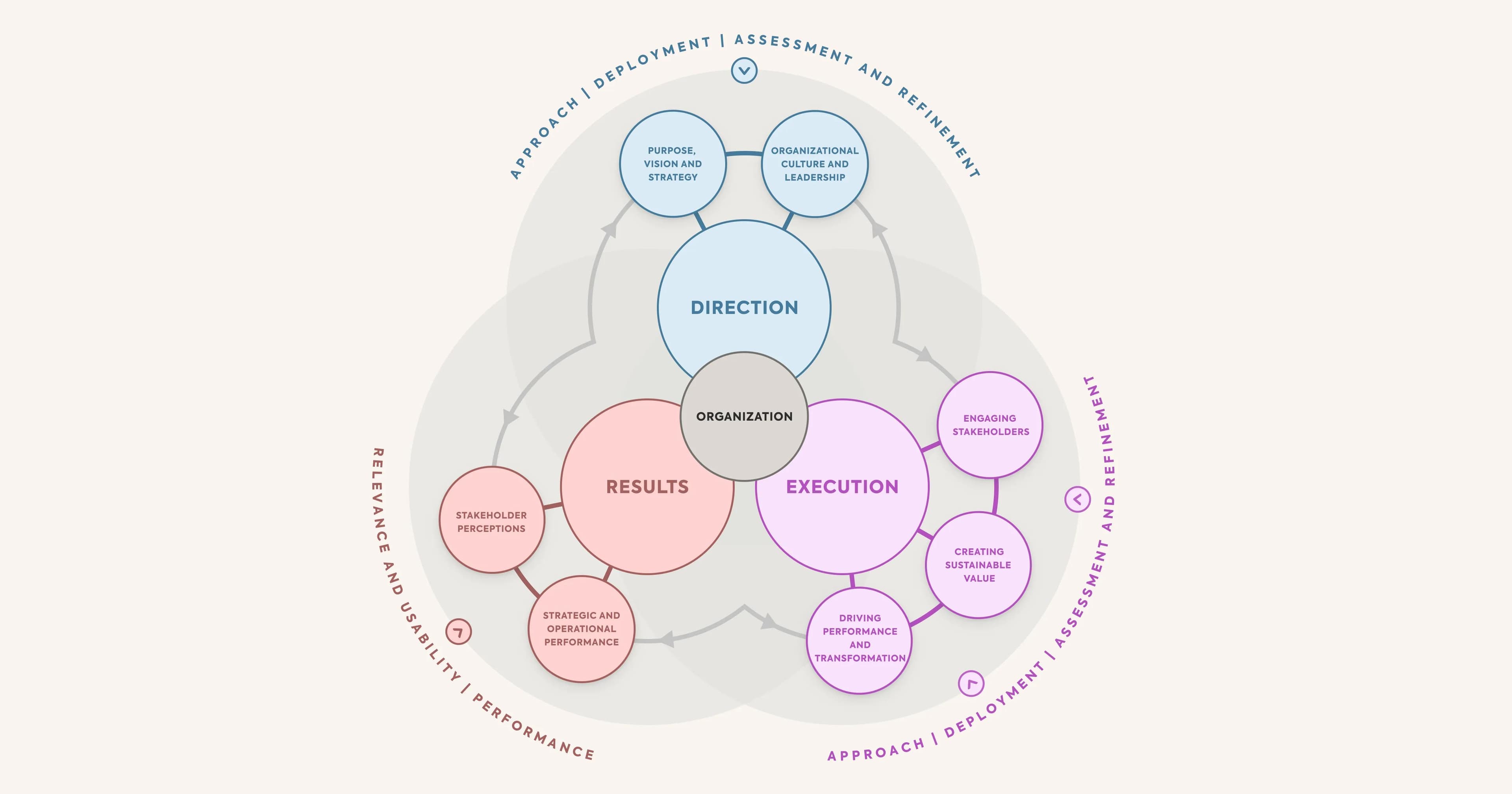
A company has developed a great product or service and created a rock-solid business plan. Next, it needs clear, measurable goals and a plan to monitor whether the goals are actually being achieved – in other words, a management framework. One such framework that focuses specifically on quality is the EFQM model (in the current version: EFQM model 2020).
This article explains what exactly is behind it, how the EFQM model works and how it can be combined with OKRs.
What to expect:
- What does EFQM mean? Definition, origin and further development
- How does the EFQM model work?
- What can the EFQM model offer? Advantages and disadvantages
- EFQM vs. OKRs in comparison
- Conclusion: Can EFQM and OKRs be combined?
- EFQM model – FAQ
What does EFQM mean? Definition
The abbreviation “EFQM” stands for the “European Foundation for Quality Management”. The foundation is not only the name giver for the concept, but has also developed it.
Overall, the EFQM model is regarded as a comprehensive quality management model. In its latest version, it is based on seven criteria and helps to understand and analyze the behavior, thinking and culture of an organization – always with the aim of improving operational performance in all areas and at all levels.
The model provides an overall view of the organization, uncovering areas for improvement while providing techniques and tools to measure improvement over time. The key here is the relationship between cause and effect: Companies should analyze what they have specifically done, what results they have achieved with it – and which gaps still exist.
In summary, the EFQM model is a management framework that focuses on quality and helps organizations to recognize where they currently are on their “path to excellence” or which steps are necessary to become (even) better.
Origin and evolution of the model
The first version of the EFQM model (also: EFQM excellence model) was published in the late 1980s. The original goal was to create a unified framework for management that would help organizations become more effective. This was intended to boost the overall competitiveness of the European economy.
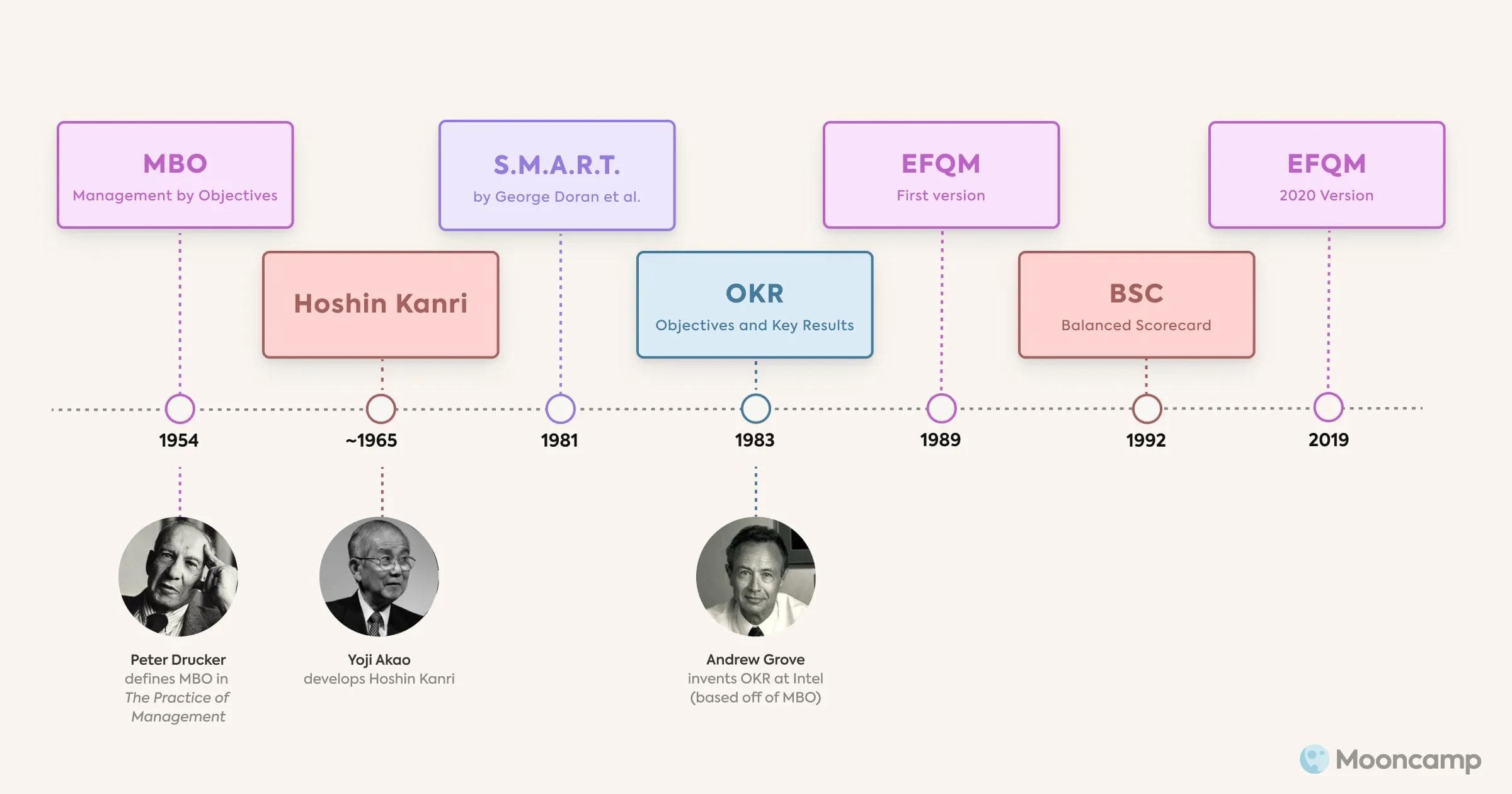
Since then, the EFQM model has been one of the leading systems in quality management. It is also under constant development. The most recent update is from 2019: The EFQM model of 2013, which had been in common use until then, was fundamentally modified and published in November 2019 as the “EFQM model 2020”.
With the latest revision, the structure of the EFQM model has been completely adapted and there is a stronger focus on corporate culture now. In this article, we take a closer look at what exactly the new structure looks like.
How does the EFQM Model work?
Overall, the EFQM model describes which requirements a company should fulfill in order to be excellent in a practice-oriented way – based on seven criteria that can be assigned to a total of three segments: direction, execution and results.
Behind these three segments is the simple but effective logic of three central questions:
- ➡️ Direction: Why does the organization exist? What purpose does it fulfill? Why this particular strategy?
- ⚙️ Execution: How does it intend to deliver on its purpose and its strategy?
- 📈 Results: What has it actually achieved to date? What does it intend to in the future?
The model thus links an organization's purpose, vision, and strategy (why) to the benefits it creates for its stakeholders (how) and sustainable excellence in results (what).
The direction
By providing a direction, an organization offers orientation to its employees (mission, vision, and values). Culture is formed and a path (strategy) is laid out.
Thus, the segment focuses completely on the future of the company and is divided into two criteria:
- 1️⃣ Purpose, vision and strategy: Outstanding organizations are defined by an inspiring purpose (mission), an aspirational vision and an effective strategy designed to create sustainable value.
- 2️⃣ Organizational culture and leadership: An excellent organization shares the same values at all levels and shapes a success-oriented culture. Strong leaders set a good example.
The execution
During execution, the focus is on implementing the strategy. This segment is subdivided into a total of three criteria:
- 3️⃣ Engaging stakeholders: Companies should know, understand and involve their stakeholders. They should take a close look at what the specific groups identified as important for their success – for example, customers, employees or society as a whole – really need.
- 4️⃣ Creating sustainable value: Good companies know that they can only remain successful and improve performance in the long term if they create sustainable value for their stakeholders.
- 5️⃣ Driving performance and transformation: Those who want to be successful today and in the future must focus on performance improvement in the present, while still remaining innovative and open to change. Ideally, change is even actively initiated and shaped.
The results
Everything a company achieves within the scope of direction and execution can be measured with the help of two central result criteria:
- 6️⃣ Stakeholder perceptions: Organizations should look at results based on feedback from key stakeholders describing their personal perceptions of the organization.
- 7️⃣ Strategic and operational performance: At the same time, organizations should also keep an eye on key performance results, that is: all the results that shed light on whether a company is succeeding to fulfill its purpose, implement its chosen strategy, create value and initiate change.
In principle, each of the seven criteria in the model can be broken down into a number of further sub-criteria, which in turn contain possible starting points for practical implementation. The following figure shows the basic structure of the model.
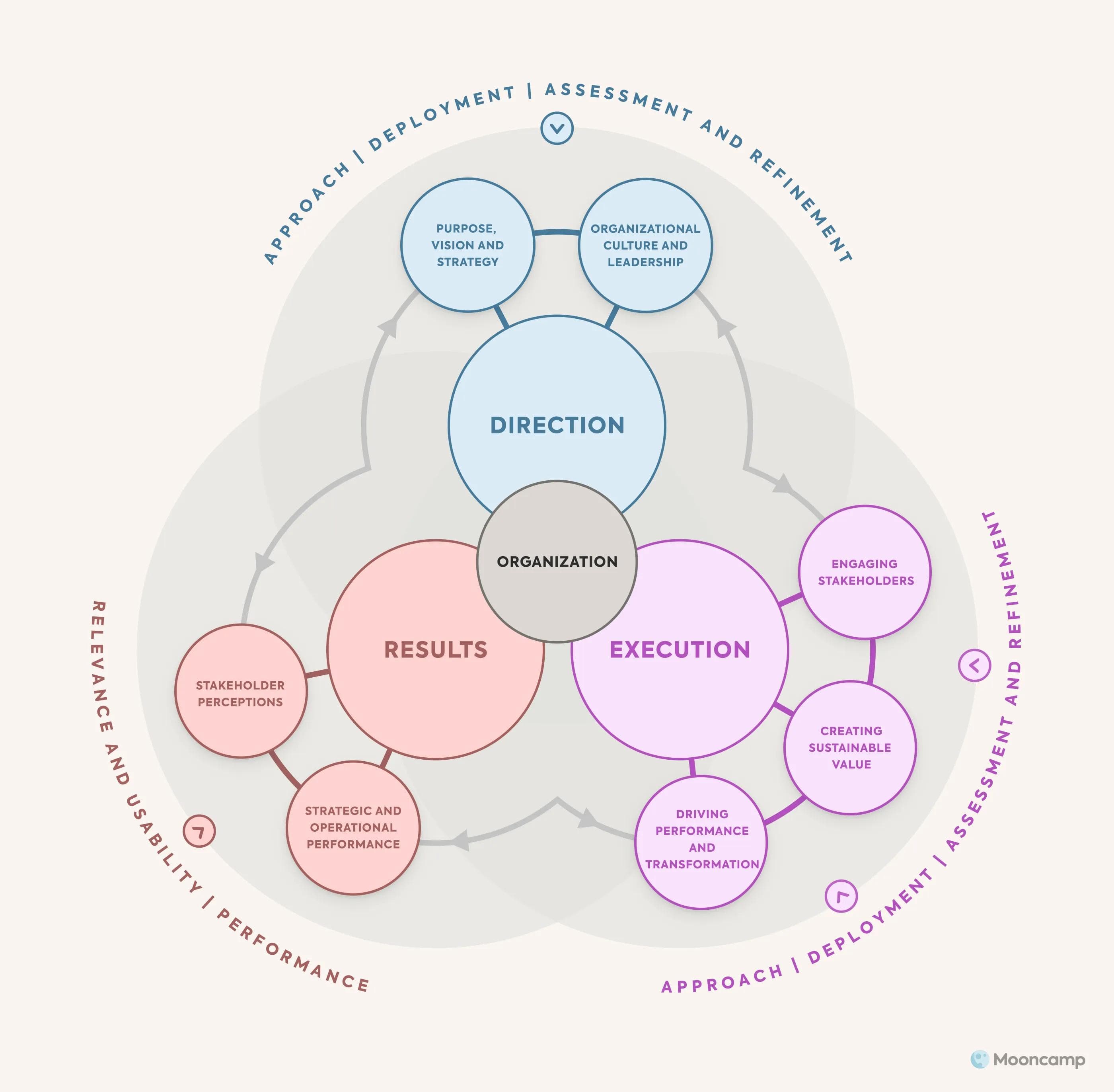
The “old” EFQM model
For comparison, in its earlier version, the EFQM model consisted of a total of nine criteria, comprising of five prerequisites (so-called “enablers”) and four results, and was essentially based on three pillars that originated in “Total Quality Management” (TQM): people, processes and results.
It was built on the premise that, as a company, you get the best results when all employees (people) are involved in the continuous improvement process.
The five enablers were:
- Leadership
- Policy and strategy
- Employees
- Resources and partnerships
- Processes
The four result criteria of the “old” EFQM model were divided into:
- Customer-oriented results
- Employee-oriented results
- Stakeholder-oriented results
- Key performance results
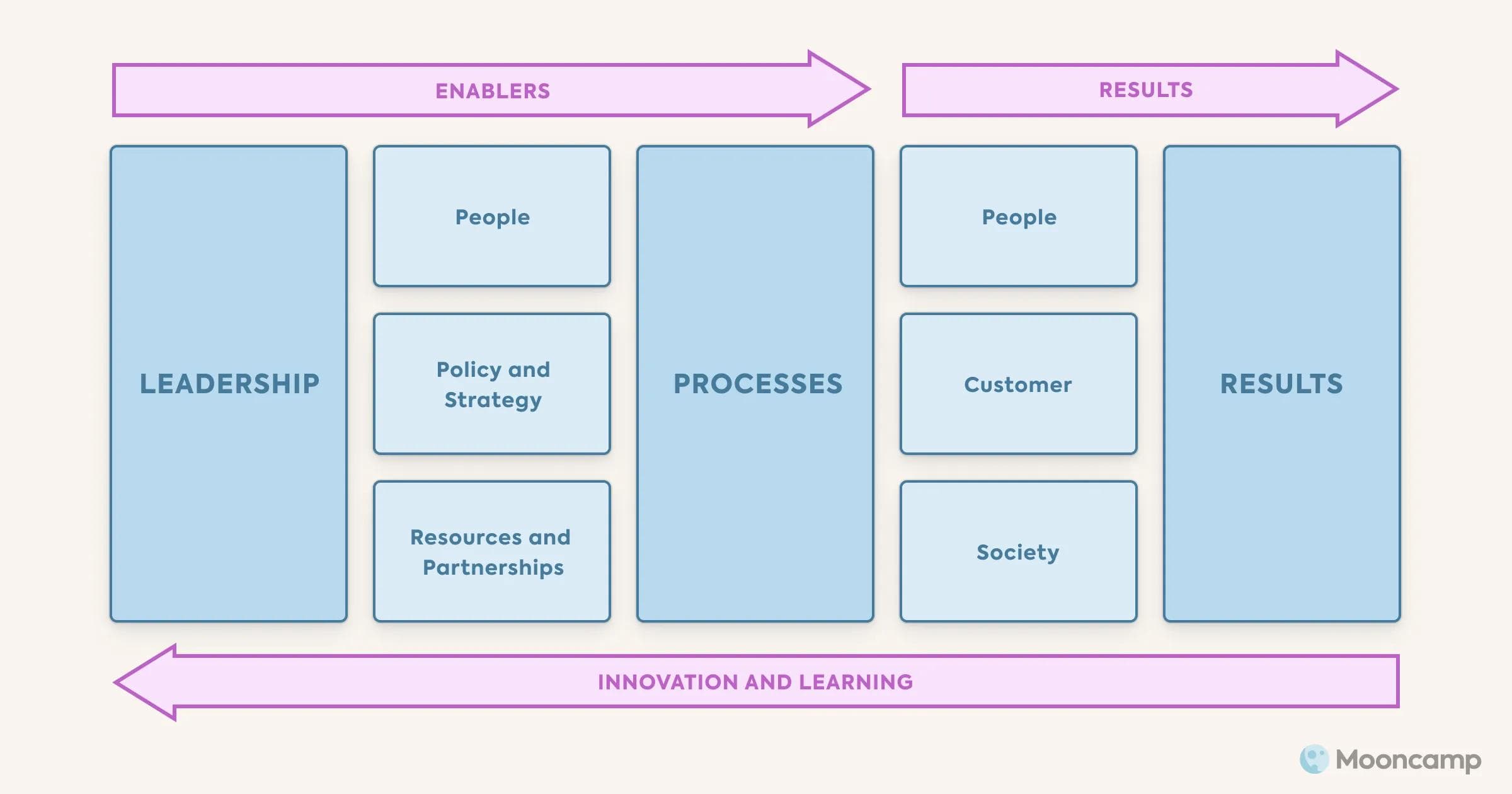
Performance management with the RADAR logic
Whether an organization performs well and successfully implements improvements is, within the EFQM model, evaluated by the company itself – according to the so-called RADAR logic.
The four letters stand for:
- Results: Define the results a company wants to achieve through a strategy.
- Approaches: Define approaches to achieve the results now and in the future.
- Deployment: Implement the approaches.
- Assess and Refine: Assess and refine the implemented approach to learn from mistakes and improve.

The RADAR logic thus describes how a company can succeed in better guiding, improving and developing its current way of working.
The evaluation usually consists of a table in which the individual segments and criteria are listed together with attributes that express the extent to which the criteria are met. Everything is then evaluated according to a specific scoring system.
What can the EFQM model offer? Advantages and disadvantages
The EFQM model helps organizations to manage change and improve their performance. As such, it offers several advantages:
- ✔️ The model helps companies define their purpose and shape a value-creating culture that focuses on common goals.
- ✔️ Changes are actively driven forward. The model provides a tried and tested framework for action to make it as smooth as possible.
- ✔️ By ensuring that processes are continuously analyzed and optimized, the model helps foster agile practices.
- ✔️ The model is open-ended and, rather than offering “the” one right way, provides a “toolbox” of different approaches from which companies can choose individually.
- ✔️ The model intensively incorporates feedback from important stakeholders to further improve an organization's performance.
At the same time, EFQM is also associated with some challenges. These are the biggest drawbacks of the framework:
- ❌ The model is geared toward long-term, continuous change management. Accordingly, it is less suitable for achieving short-term goals.
- ❌ It is a self-assessment framework that requires a lot of discipline, and it is questionable whether the assessment can actually be done objectively and honestly enough with the simple assessment tool.
- ❌ Many terms within the model are vaguely formulated or not sufficiently defined. This makes it more difficult to work with.
- ❌ In order to implement the very comprehensive model, it is imperative to have a high level of commitment and strong leadership at all levels of the company.
- ❌ The model is very broad and therefore complex to implement. It only works at a superordinate corporate level, not for individual teams or employees.
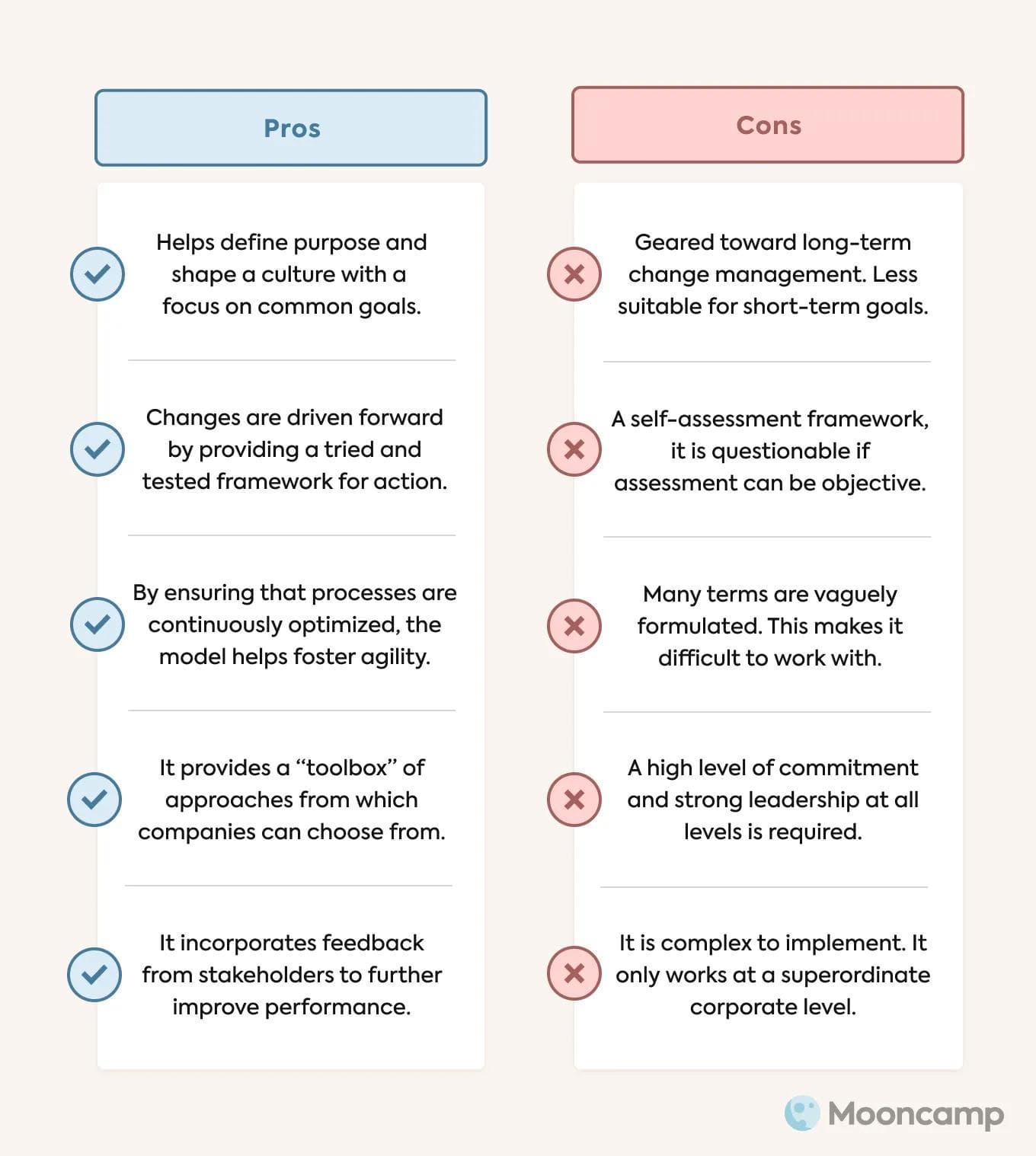
EFQM vs. OKRs in comparison
In addition to EFQM, there are many other management concepts designed to make companies strategically better and move them forward – each with a different focus.
💡 Tip: Balanced Scorecard, Hoshin Kanri, MBO, OGSM and OKR are some examples of management frameworks worth taking a closer look at.
At first glance, OKRs – short for “Objectives and Key Results” – seem to have little in common with EFQM, nor do they offer any particular opportunities for integration. However, if one takes on closer inspection, it becomes clear that, especially the latter, is not quite correct.
💡 Tip: If you want to read up on OKRs in more depth, it's best to take a look at our OKR guide or browse through even more exciting articles on our blog.
Yes, the two frameworks have some quite ⚡ fundamental differences, but also 🤝 similarities:
- ⚡ Focus: The EFQM model, when compared to OKRs, is much broader in scope. It primarily defines conceptually what a company wants to achieve as a whole (with a focus on quality management). OKRs center around goals and their concrete realization in everyday work – both individually in the team and at the corporate level.
- ⚡ Access: Because it is quite complex, the EFQM model is not (or only with difficulty) accessible to individual employees. OKRs can be implemented individually or in small teams. They are easy to understand for everyone in the company.
- ⚡ Transparency: The linchpin of the EFQM model is the management level. It is often difficult for employees who are supposed to implement the strategy to have a complete overview of the concept. OKRs are usually created in a simple, transparent and team-oriented manner, top-down and bottom-up.
- ⚡ Frequency: EFQM is designed for long-term changes, while OKRs are set more short-term, usually every three to four months, and reviewed in check-ins.
- 🤝 Ambition: Both frameworks set ambitious goals for the company. Errors are seen as opportunities for learning and potential for improvement.
- 🤝⚡ Adaptability: Both frameworks are flexible, but differ in the details: OKRs are usually reset quarterly and reviewed regularly. EFQM strives for excellence for fixed topics and focuses on continuous improvement.

Conclusion: Can EFQM and OKRs be combined?
Overall, these are two very different frameworks with very different goals, which can nevertheless (or precisely because of this) work well together.
The EFQM model is broader in scope and can be applied to create an overarching, long-term management strategy whose concrete implementation is supported by OKRs.
For example, OKRs could be used to gradually address the open points from the EFQM self-assessments in a quarterly rhythm and benefit from the ideas and suggestions of the entire team by defining the OKRs together with the employees.
In doing so, the simple and to the point Objectives and Key Results balance the complexity of the EFQM model and ensure that all employees understand how they can individually contribute to the implementation of the corporate strategy (vision).
EFQM Model – FAQ
What is the goal of EFQM?
The goal of the EFQM model is to help organizations manage change and improve their performance and the quality of their results. The aim is continuous improvement up to excellence.
Who uses EFQM?
The EFQM model is one of the most widespread management frameworks, used equally by global corporations, SMEs and public institutions in various industries. EFQM is particularly recommended for companies that already have a quality management system and would like to perfect it.
Why is the EFQM model useful?
The model helps organizations measure where they currently stand on the path to becoming an excellent company and helps identify and understand gaps and areas for improvement. It also offers suggestions on what actions can be implemented to close the gaps and become even better.
